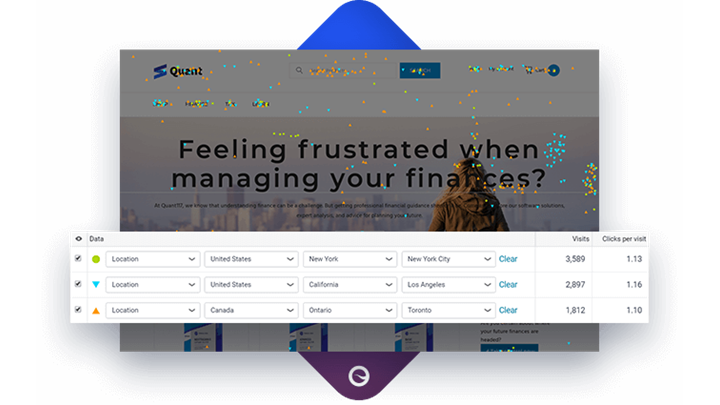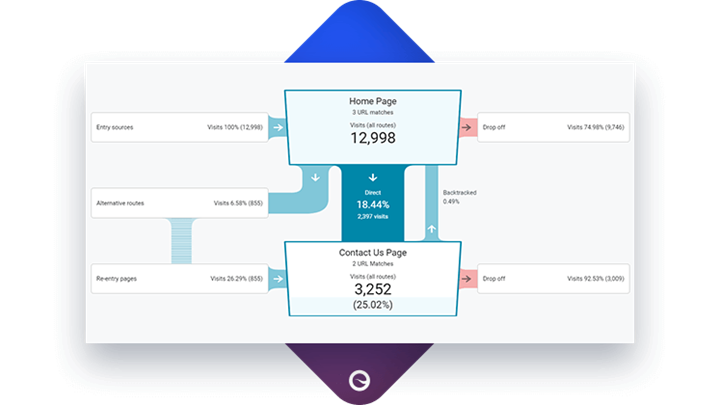Website visitor tracking 101
As a website owner, you’re undoubtedly familiar with web analytics tools. They provide valuable statistics on website visits and help you track overall site performance. But to get a more detailed picture of customer behavior, it helps to visualize how individual visitors actually navigate your site. That’s what website visitor tracking is for.
What is website visitor tracking?
Website visitor tracking is the process of logging the way visitors engage with your site and then visualizing that behavior in a meaningful way. It helps website owners better understand the individual user’s path through a site, identify potential bottlenecks, and then optimize user journeys based on these insights.
How does website visitor tracking work?
Website visitor tracking tools typically work via a special script installed on your site. This script logs key actions visitors take such as clicks, scrolls, mouse movements, and so on.
The recorded user behavior can then be displayed in various ways, either by aggregating lots of visitors’ activities into a consolidated overview or letting site owners view session recordings for each individual visitor.
The different kinds of website visitor tracking
No single report can give you the full picture of your visitor behavior. That’s why you have several separate ways to track and visualize what people do on your site.
1. Behavior maps
This form of tracking provides an aggregated view of all visitor behavior on a single page of your site. It quite literally tries to “map” this behavior onto the page by displaying a color-coded overlay over it that shows which areas get the most attention.
This usually takes the form of heat maps, click maps, and scroll maps. These show where users place the mouse, where they click, and how far they scroll down the page, respectively. Areas of high activity will be marked red, and areas without activity will be blue.
Behavior maps are a very effective and intuitive way to get page-level insights for a large number of users in a single static snapshot.

2. User recordings
User recordings are the opposite extreme. Instead of combining data from multiple visitors to a single page, user recordings let you view the entire visit of a single user. They basically record every action a user takes from the moment they enter your site to the moment they exit it.
You can then “relive” that visit in real time by watching a video recording of it (although you do have the option to change playback speed, etc.). It’s the equivalent of looking over that visitor’s shoulder as they browse your site.
While not effective at measuring the general site performance, user recordings are perhaps the most intimate form of understanding user behavior. You can almost feel a user’s frustration as they fumble around the site for minutes in search of information or repeatedly try and fail to submit a broken contact form.
Because of this, user recordings are an extremely powerful tool for visualizing major leaks in your funnel and getting organizational buy-in to fix these.
3. User journey mapping
User journey mapping can be seen as a sort of hybrid between behavior maps and user recordings. A user journey map illustrates the way visitors flow between two distinct pages of your site by marking all alternative paths between these pages. This is supplemented with quantitative data about how many people visit each intermediate page, how many drop off at each stage, and so on.
This helps you evaluate your existing conversion funnels, identify the biggest leaks, and design more effective customer journeys.
In practice, you’ll often be using the different kinds of visitor tracking in unison. You might first identify a page-level issue by looking at a user journey map, then pull up a behavior map of that page to see why it fails to perform, then review a few representative user recordings of the journey to discover how to design a better one.

What are the benefits of using visitor tracking on your website?
Visitor tracking supplements your other web analytics tools.
In many ways, visitor tracking gives you more actionable insights, because it often shows you exactly how to fix certain page-level issues or ineffective user journeys. It’s the closest you’ll get to directly interviewing your site visitors without actually doing so.
With website visitor tracking, you can...
1. Get better insights about your users
By zooming in on either the individual visitor or a single page, you gain a deeper understanding of exactly how users interact with your site. You can even begin to segment your users based on their intended goals and figure out how to design better journeys for different audiences.
2. Increase conversion rates
Thanks to visitor tracking, you can often spot and eliminate irrelevant elements that distract users from their goal. Similarly, identifying hotspots on a page may help you place key CTA buttons in more accessible locations.
When acted upon, visitor tracking data lets you create a smoother experience for your users, making sure that more of them reach their intended destination. In turn, this ends up increasing your conversion rates.
3. Refine your content strategy
Tracking visitor behavior is also helpful for assessing how effective your content strategy is. Do people read all the way through that long product page? Do they move from one piece of content to another as you’ve envisioned?
You can even identify gaps in your content or spot underperforming content elements. For instance, you may discover that most visitors never see that helpful “How to” video, because it’s buried at the bottom of a page where few people ever scroll. You may then redesign the page to make the support section easily accessible and present people with the information they’re looking for upfront.
Website visitor tracking with Siteimprove
The Siteimprove platform offers an all-in-one suite of visitor tracking tools to help you improve user journeys and conversions. By using Siteimprove, you get access to:
- A web analytics solution that integrates easily with your existing MarTech stack
- Behavior maps including click maps, heat maps, scroll maps, and segmentation maps ( how users from specific locations engage with your site)
- User behavior tracking and user recordings
- Custom funnels that let you set up and analyze your own user journeys and behavior patterns
- Custom metrics to help you track specific site goals that you consider relevant
- Support and training, so you can get the most value out of every available tool
Wir beantworten Ihre Fragen gerne.
Die Zusammenarbeit mit einem neuen Technologiepartner ist eine wichtige Entscheidung. Wir sind hier, um alle Fragen zu beantworten, die Sie haben.
Beratungstermin vereinbaren